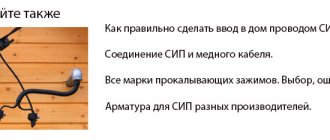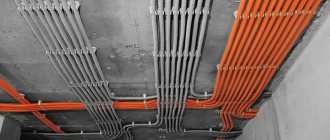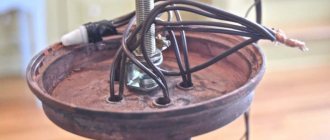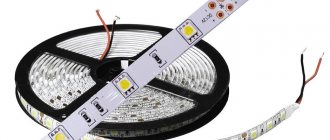If you need to hang a chandelier weighing several kilograms on the ceiling, then there are usually no difficulties. But when hanging a massive heavy chandelier, work needs to be done by choosing the type of fastener and the correct method of fastening.
The chandelier hangs at a height, is connected to electrical wiring, people pass under it, so the reliability of the fastening must be taken with full responsibility in order to prevent the lamp from falling on someone’s head.
If the lamp weighs less than a kilogram and is an electric socket with a light bulb, then you don’t have to worry about the hanging method and attach the chandelier directly to the electrical wires. I used this method of hanging during the renovation of the apartment since all the lamps were removed from the ceiling. If the chandelier consists of fittings and shades, then it is necessary to install a special mount in the ceiling in the form of a hook or anchor.
Types of chandeliers and features of their fastening
Fasteners for a chandelier are selected based on its type. By type, lamps are divided into ceiling and pendant. The latter are devices attached to the ceiling at some distance using a cord, chain or rod. Such devices are ideal for rooms with high walls. As a rule, they have several shades directed up, down or to the sides. A hook is usually used to secure this type of device.
Ceiling chandeliers are designed for rooms with low ceilings. They provide less light, so they are often installed in corridors, bathrooms, and kitchens. The shape can be oval, round, square or rectangular. They consist of a frame plate on which the lampshades are fixed, and a decorative overlay made of glass or plastic. A special strip is used as a fastener for chandeliers of round or oval shapes of different sizes.
Requirements for the lighting device
Not all homeowners who have installed a suspended ceiling know that not every chandelier can be attached to it.
This type of lighting device is subject to a whole list of requirements regarding:
- Location of lampshades
. Chandeliers in which they are directed to the sides and downwards are suitable. It is impossible to install devices if their lampshades “look” upward, since as a result of the effect of heat on the canvas, stains appear on it. The reason for this phenomenon is the property of polyvinyl chloride to change when heated. - Base material
. Preference should be given to products that are not made of metal. The reason is that with prolonged use of the chandelier, the metal elements begin to heat up and as a result of contact, deformation of the ceiling surface occurs, which manifests itself in the form of spots and stains. - Availability of a universal lampshade
. Today the choice of chandeliers is huge, but the most practical choice is still a universal lampshade. Energy-saving lamps are suitable for it, since they do not heat up and do not have a negative effect on the stretch fabric. - Ceiling depths
. It is better to purchase chandeliers whose lamps are completely covered, as this will protect the ceiling surface from the influence of artificial lighting. In the absence of a lampshade, when it is made in the form of a decorative base, you can only use energy-saving lamps with low power. - Distances from the lampshade to the canvas
. It must be at least 20 centimeters, otherwise the panel will not last long and defects will soon appear on its surface as a result of heating the material. - Polyvinyl chloride films
. The fabric made from it is elastic, but too thin. Therefore, it can be easily damaged by sharp objects, which means the chandelier should have a streamlined shape. - Incandescent lamps
. In a chandelier it is permissible to use lamps with a power of no more than 40 W, otherwise too high a temperature will cause rapid deterioration of the panel.
Types and methods of fastening
There are several types of chandelier mounting:
- hook;
- bracket;
- plank
Usually, the instructions for the lighting device indicate the appropriate installation method, and in some, everything necessary is supplied in the kit. However, sometimes standard mounting methods are not suitable, for example, when you need to attach a suspended chandelier to a suspended ceiling without a hook.
Installation with ceiling hook
The easiest way to attach a hanging chandelier is to use a special hook. You can carry out installation even without any special skills.
It is important to understand that this method is only suitable for solid foundations: concrete, wood. If the surface of the ceiling is covered with decorative material (plasterboard, plastic panels), you need to dismantle them and install the fasteners directly on the base ceiling.
When installing a lamp weighing up to 4 kg, a simplified technology is allowed: a hole is drilled in the ceiling to fit the dimensions of the fastener, a dowel is driven in, and a threaded hook is screwed in. When working with a wooden ceiling, they do without a dowel - the fasteners are screwed directly into the hole.
For massive products whose weight exceeds 4 kg, more thorough fastening will be required. It is best to use an anchor bolt (butterfly). It is securely fixed to the base, withstanding heavy loads. An anchor is inserted into the drilled hole and tightened until it stops. Fix the lamp and connect the wires. To disguise the fastening, a special bowl cover is put on the hook.
Advice! To prevent the dust generated during drilling from flying into your eyes and scattering around the room, put a plastic or paper cup over the drill.
Installation using a mounting strip
The strip is a type of fastening designed for ceiling lamps. It is a plate fixed to the ceiling using self-tapping screws, onto which the lighting fixture is subsequently mounted.
Preparation
Any work should begin with preparatory activities, especially if a newbie takes on the job and will have to do everything for the first time. This will avoid many mistakes and save your time. Before hanging the lamp, you should prepare in detail all the necessary tools and devices, and take care to comply with basic safety rules.
Safety precautions
Hanging a chandelier from the ceiling in a 220 V household network is a highly dangerous job. Firstly, there is a danger of electric shock, which can lead to very disastrous consequences. Secondly, you will work at height, which is also fraught with falls, bruises and even fractures. Thirdly, there is a danger of damage from glass and other sharp elements to lampshades, glass beads and other parts.
Therefore, if you decide to hang a chandelier, be sure to follow these rules:
- Before hanging the chandelier, be sure to turn off the power to this section of the circuit using the machine; do not rely on the key switch, it may not be enough.
Disable machine
- Check for no voltage using an indicator screwdriver or multimeter. Please note that testing by pressing the switch does not provide a 100% guarantee that the phase does not reach the cable cores.
- Climbing to a height should only be done with the help of a reliable, stable base; the ideal option would be a stepladder that someone in the household will hold for you.
- When drilling the ceiling, it is better to use glasses to protect your eyes from debris, concrete fragments, dust, etc.
- When hanging a chandelier, it is necessary to remove from it all excess glass parts that may fall and break or not install them.
- The same applies to lamps, especially fluorescent ones; they cannot be installed before hanging the chandelier. The latter contain mercury and, if the integrity of the flask is damaged, will lead to the release of harmful substances into the airspace of the room.
If the chandelier has flammable parts, then it is strictly forbidden to use incandescent lamps in them, as they can lead to overheating and fire.
Required tools and materials
Like any work, installing a chandelier requires preliminary preparation of consumables. Most often, materials are required for connecting wires - terminals, sleeves, soldering, bolting, etc. It is important to know that the use of twists to ensure electrical contact is strictly prohibited. To fix the chandelier on the ceiling, you will need fasteners - strips, hooks, brackets, dowels, which are selected depending on the type of ceiling covering.
Among the tools prepared in advance you will need:
- A hammer drill, a screwdriver or an electric drill - depending on the material to which you will attach the chandelier;
Hand Drilling Tool
- Mechanic's tools - pliers, screwdrivers, wire strippers, stationery knife, electrical tape;
- Measuring instruments – indicator, multimeter, non-contact tester;
- Device for lifting to heights.
You will not need all of the above tools to connect a chandelier. Therefore, in each specific case the list is selected individually.
- Phase indicator and wire phasing
Indicator screwdriver
An indicator screwdriver can have several designs, but their main task is to show the presence of potential on the current-carrying conductor. To use it, you need to turn off the power to the output under the chandelier and strip the edge of the wire. If the ends are covered with electrical tape, simply remove the insulation. Then touch the phase indicator to the terminals of the electrical wiring; if the screwdriver does not light up anywhere, then there is no voltage.
Please note that before starting work, be sure to check the functionality of the indicator on those parts that are known to be live. You can also take a wireless indicator, it is safer and there is no need to touch bare wires.
Methods for attaching chandeliers to different types of ceilings
The correctly chosen method of installing the lamp allows you not only to firmly fix the device, but also to do it in such a way as not to worsen the appearance of the ceiling. The fasteners included with the chandelier are not always suitable for this purpose: different surfaces have their own characteristics. For example, if a plank is selected as the mounting type for a suspended ceiling, then the base for it must be installed before installing the gypsum board.
Plasterboard ceiling
A plasterboard structure is a suspended ceiling that is located a few cm below the floor slab, making it easy to hide communications in the resulting space. However, when installing a lamp on a plasterboard ceiling, certain difficulties arise. Ideally, all work is performed during the construction of the frame and its cladding.
Mandatory preparatory activities
In order to cope with the task and do everything correctly, you need to prepare the tools so that during the process of installing the chandelier on the ceiling nothing distracts the master:
- you need a stepladder of sufficient height (you can get by with a table);
- hand-held electric drill or hammer drill;
- pliers and wire cutters or side cutters (from electric shock, handles must be insulated);
- various screwdrivers (including with indicator function);
- a roll of electrical tape;
- several mounting blocks (with a reserve) for wire clamps;
- the necessary fasteners on which the chandelier will be installed on the ceiling.
Before fixing the ceiling chandelier, be sure to read the instructions for connecting it to the electrical network. Usually it gives a detailed description of all operations, so a master who knows a little about electricity should not have any particular difficulties.
Connecting electrical wiring
Connecting the chandelier to the electrical network is an important step when installing a ceiling lamp. First of all, you need to determine the types of cables on the ceiling. There can be 2 or 3 of them, most often they differ in color:
- blue – zero;
- red, brown or black – phase;
- green-yellow – grounding.
If the marking is missing or there are doubts about its correctness, do this:
- turn on electricity in the room;
- an indicator screwdriver is applied sequentially to the bare end of each cable - when contacting the zero, the indicator does not light up, but when contacting the phase, it lights up.
From each lampshade of the chandelier there are 2 marked wires (zero, phase). They need to be collected into 2 groups according to type, twisted, and both of these twists should be connected to those on the ceiling. Connect them using terminals.
Installation under a two-key switch
If you want to install a chandelier under a two-key switch (that is, one key turns on only part of the light bulbs, and two keys together turn on all the light bulbs at the same time), the principle changes slightly. In this case, all the zeros of the chandelier are connected together and connected to the mains zero, and the phases are divided into groups.
In the first group it is necessary to combine all the phase conductors of the lamps that should light up from the first switch, in the second - from the second. Next, the first group is connected to the phase coming from the first key, the second - to the phase from the second key. The installation of the chandelier can be considered complete once it is attached.
Diagram of connecting wires to a two-key switch
Required Tools
To attach the chandelier to the ceiling you will need:
- a stable chair or stepladder;
- indicator screwdriver;
- insulating tape;
- chandelier fasteners;
- drill or hammer drill with a set of drills;
- hammer;
- screwdriver;
- dowels
Important! Before installing the ceiling lamp, you should turn off the power to the room in which the work will take place. You can make sure that no current is supplied by using an indicator screwdriver (it must be brought close to the wiring).
How to determine the location of wiring in the ceiling?
Before hanging a chandelier on a concrete ceiling, you need to know the exact location of the electrical wiring. If this is not done, when drilling holes for the chandelier fasteners, it will be possible to easily drill through the wires. The search process must be performed while current is flowing in the wires. Therefore, this procedure can be divided into the following stages:
- Power outage.
- Installing a temporary socket with a light bulb.
- Electricity supply.
- Turning on the temporary light.
To determine the location of live wires, there are many devices from different price categories. This device must be installed perpendicular to the line along which the wiring is supposed to run. You must place a mark where the phase is detected, and then continue moving the indicator. The next mark is placed at the point where the phase disappears.
To control, these steps should be repeated in the opposite direction. The wiring is laid in the gap between the resulting marks. Now you can safely drill holes for fasteners and hang the chandelier.
Finding wiring on the ceiling
Useful tips from experts
To create high-quality indoor lighting and avoid installation errors, it is worth studying the recommendations of electricians:
- The location where the lamp will be located should be determined during the renovation work. This way you can route the wiring to the desired area, and you won’t have to extend the cable if it’s not long enough.
- Before installation, it is advisable to remove lampshades and other decorative elements from the device: the weight of the chandelier will decrease, it will be easier to work, and fragile parts will not be damaged.
- Be sure to study the information in the technical data sheet of the device - it indicates the weight, type of chandelier mounting, and other useful information.
- All work must be carried out after turning off the electricity supply.
Choosing a suitable chandelier mount and installing the lamp yourself is a completely feasible task. The main thing is to approach the process competently, study the recommendations of the lighting device manufacturer in the data sheet and take into account the type of ceiling. It is very important to follow safety precautions when connecting wires.
Did you manage to solve your problem using the recommendations from the article?
Yes!
46.33%
No. More answers required. I'll ask in the comments now.
38.06%
Partially. There are still questions. I'll write in the comments now.
15.62%
Voted: 762











